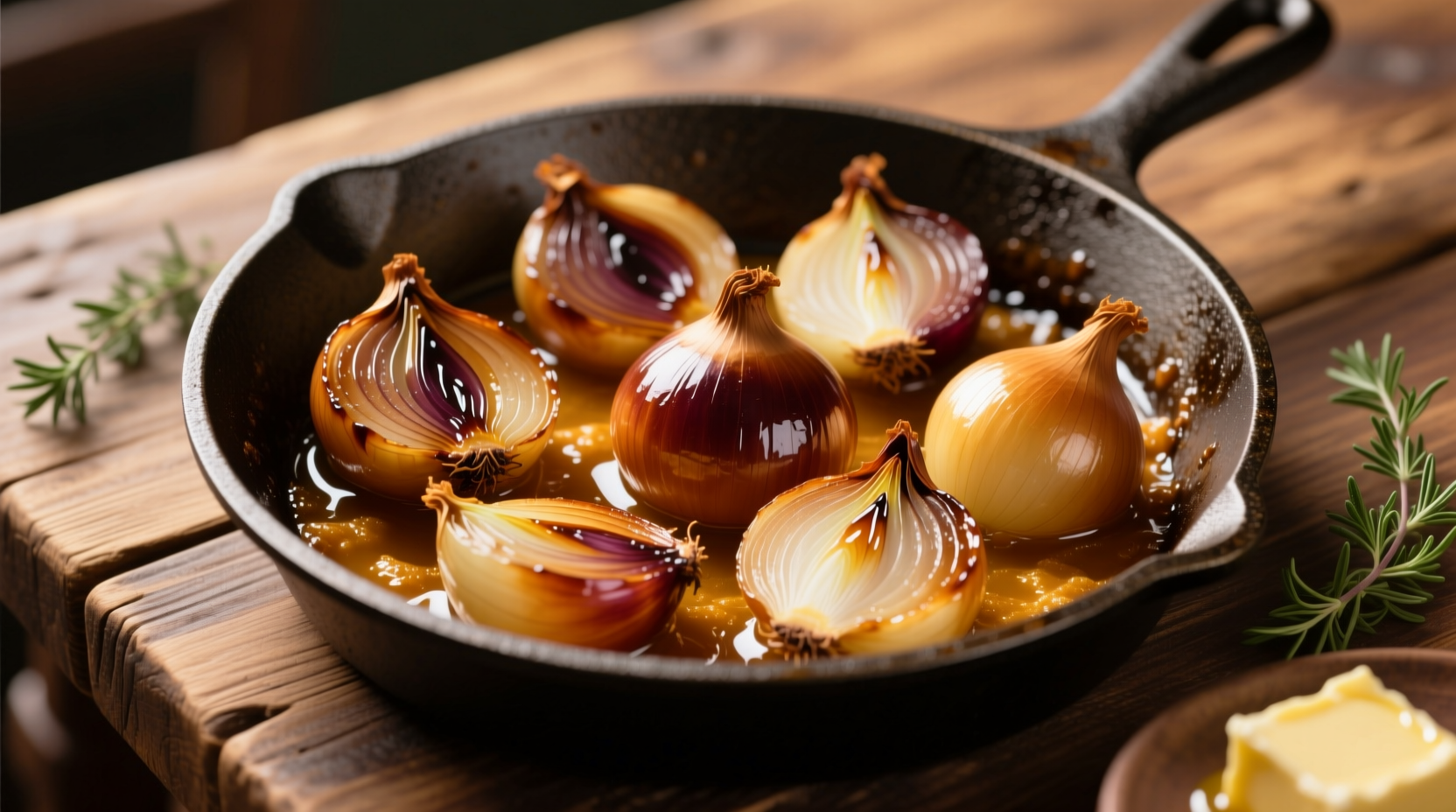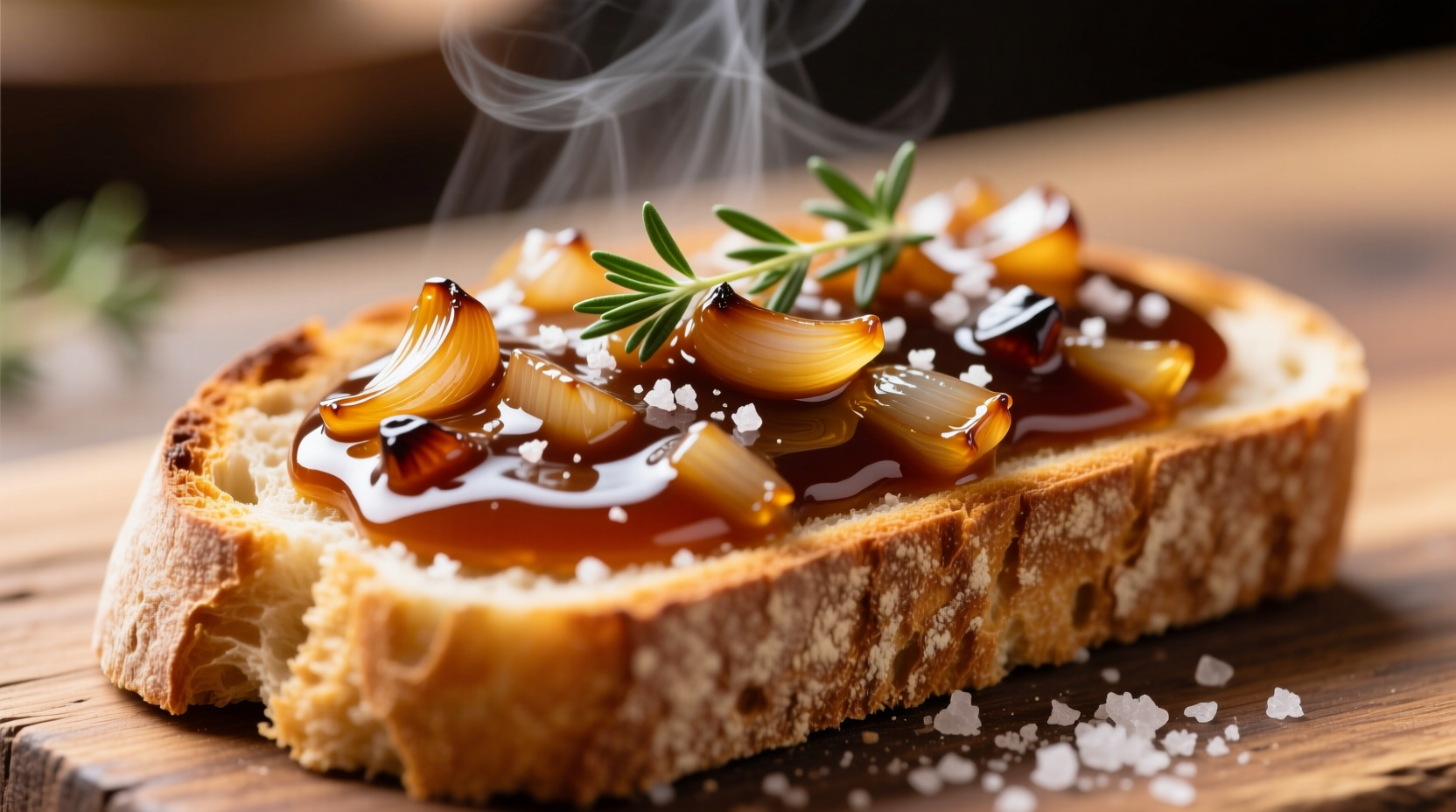The Science Behind Perfect Caramelized Onion Sauce
Understanding the chemistry of caramelization separates good results from exceptional ones. When onions cook slowly, two key processes occur: the Maillard reaction (amino acids reacting with reducing sugars at 285°F/130°C) and actual sugar caramelization (starting around 320°F/160°C). Unlike popular belief, onions contain natural sugars—about 5 grams per 100g—that release during cooking, eliminating the need for added sugar in most recipes.
According to the USDA FoodData Central, yellow onions contain higher sugar content (4.2g per 100g) compared to red onions (3.9g), making them ideal for caramelization. The slow cooking process breaks down sulfur compounds responsible for raw onion's sharpness, transforming them into sweet, complex flavor molecules.
Essential Ingredients and Equipment Checklist
Professional chefs consistently emphasize these non-negotiable elements:
- Onion selection: Yellow onions provide optimal balance of sweetness and structure
- Fat medium: Butter (for flavor) combined with oil (for higher smoke point)
- Proper pan: Heavy-bottomed skillet or Dutch oven for even heat distribution
- Patience tool: Wooden spoon for gentle stirring without breaking down onions
| Onion Variety | Sugar Content (per 100g) | Best For Caramelization | Flavor Profile |
|---|---|---|---|
| Yellow Onions | 4.2g | ★★★★★ | Rich, balanced sweetness |
| Vidalia Onions | 5.1g | ★★★★☆ | Very sweet, less complex |
| Red Onions | 3.9g | ★★★☆☆ | Fruity notes, slightly bitter |
| Shallots | 7.9g | ★★★☆☆ | Intense sweetness, delicate texture |
Step-by-Step Caramelization Process
Follow this professional technique for foolproof results every time:
- Prep onions properly: Slice uniformly (1/8 inch thick) using a sharp knife or mandoline
- Heat control: Medium-low heat (325°F/163°C) in preheated pan with 2 tbsp oil + 1 tbsp butter
- Salt early: Add 1/2 tsp salt immediately to draw out moisture and speed cooking
- Stir strategically: Every 5-7 minutes during first 20 minutes, then more frequently
- Scrape fond: Use deglazing with 1-2 tbsp water or broth when brown bits form
- Final stage: Cook 10-15 minutes after onions turn deep golden for maximum flavor development

Caramelization Timeline: What to Expect
Understanding these visual and textural milestones prevents common mistakes:
- 0-10 minutes: Onions release water, becoming translucent with some browning at edges
- 10-25 minutes: Moisture evaporates, onions soften and begin golden browning
- 25-40 minutes: Onions turn light golden brown, stirring reveals fond developing on pan bottom
- 40-50 minutes: Deep golden color achieved, texture becomes jam-like with concentrated flavor
- 50-60 minutes: Optimal stage—rich mahogany color with complex sweet-savory balance
Exceeding 60 minutes risks bitterness as sugars begin to burn. The National Institute of Food and Agriculture confirms that proper caramelization develops over 45-60 minutes at controlled temperatures, with the most significant flavor compounds forming during the final 15 minutes.
Avoid These 3 Common Caramelization Mistakes
Even experienced home cooks frequently make these errors:
- High heat shortcut: Causes uneven cooking—edges burn while centers remain raw
- Overcrowded pan: Creates steam that prevents proper browning (use 3-4 onions per 10" skillet)
- Insufficient salt: Without early salting, onions take 25% longer to caramelize properly
Storage Guidelines and Shelf Life
Preserve your caramelized onion sauce with these food safety practices:
- Refrigeration: Store in airtight container for up to 5 days
- Freezing: Portion into ice cube trays, then transfer to freezer bags for 3 months
- Reheating: Gently warm in skillet with splash of water to restore texture
- Signs of spoilage: Discard if mold appears or sour odor develops
The FDA Food Code recommends refrigerating cooked vegetables within 2 hours, with maximum safe storage of 7 days for optimal quality. For extended preservation, acidification with vinegar (1 tbsp per cup) can extend refrigerator life to 10 days.
Creative Applications Beyond the Basics
Elevate everyday dishes with these professional chef techniques:
- Meat enhancement: Spread under chicken skin before roasting for flavor infusion
- Sandwich transformation: Mix with mayo for gourmet burgers or grilled cheese
- Pizza foundation: Use as base instead of tomato sauce for white pizzas
- Vegetarian boost: Stir into lentil soup or mushroom risotto for umami depth
- Breakfast upgrade: Top scrambled eggs or frittatas for sophisticated morning meal
Variations for Different Cuisines
Adapt caramelized onion sauce to complement global flavors:
- French style: Add thyme sprig and bay leaf during cooking, finish with splash of red wine
- Middle Eastern: Stir in cumin and sumac after caramelization completes
- Asian fusion: Deglaze with rice vinegar and finish with toasted sesame oil
- Mexican twist: Add chipotle pepper in adobo sauce during final cooking minutes
Perfect Pairings for Maximum Flavor Impact
These combinations create restaurant-quality results at home:
- Proteins: Steak, pork tenderloin, roasted chicken, grilled portobello mushrooms
- Carbohydrates: Mashed potatoes, polenta, crusty bread, egg noodles
- Cheeses: Gruyère, blue cheese, goat cheese, aged cheddar
- Vegetables: Roasted carrots, Brussels sprouts, asparagus, roasted garlic
Troubleshooting Guide
Solve common issues with these quick fixes:
- Too watery: Return to heat and cook 5-7 minutes more to evaporate excess moisture
- Burnt spots: Immediately transfer to clean pan, leaving burnt bits behind
- Not sweet enough: Add pinch of sugar and cook 3 more minutes (indicates insufficient cooking time)
- Bitter taste: Balance with 1/2 tsp apple cider vinegar to cut harshness
Frequently Asked Questions
How long does it take to properly caramelize onions for sauce?
True caramelization requires 40-60 minutes of slow cooking. Rushing the process with high heat creates uneven results—some parts burn while others remain raw. The most significant flavor development occurs during the final 15 minutes when onions transform from golden to deep mahogany.
Do I need to add sugar when making caramelized onion sauce?
No added sugar is necessary. Onions naturally contain 4-8% sugars that release during cooking. Yellow onions (4.2g sugar per 100g) provide sufficient natural sweetness. Adding sugar can cause premature burning and creates an artificial flavor profile compared to naturally developed caramelization.
Can I speed up caramelization with baking soda?
While a pinch of baking soda (1/16 tsp per pound of onions) can accelerate browning by raising pH, it creates a mushy texture and soapy flavor. Professional chefs recommend patience over chemical shortcuts for optimal texture and complex flavor development through natural caramelization processes.
What's the best fat to use for caramelized onion sauce?
Combine 1 part butter with 2 parts neutral oil (like canola or grapeseed). Butter provides rich flavor but burns at 300°F, while oil has a higher smoke point (400°F+). This combination delivers optimal flavor without burning. Avoid olive oil for high-heat caramelization as its low smoke point creates bitter compounds.
How can I fix bitter caramelized onions?
Bitterness indicates burning. Immediately transfer onions to a clean pan, leaving burnt bits behind. Add 1-2 tbsp water or broth and gently scrape the new pan bottom. Balance bitterness with 1/2 tsp apple cider vinegar or a small splash of sweet sherry. For severe burning, start over as burnt compounds cannot be fully masked.











 浙公网安备
33010002000092号
浙公网安备
33010002000092号 浙B2-20120091-4
浙B2-20120091-4